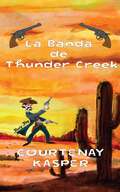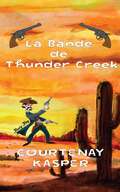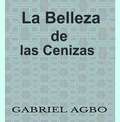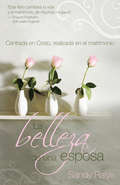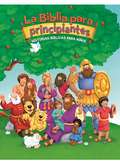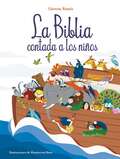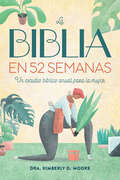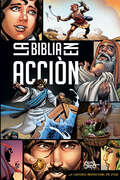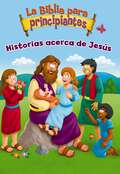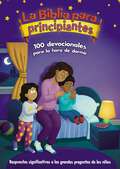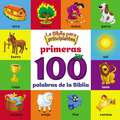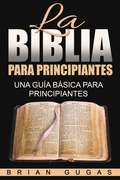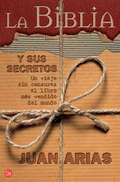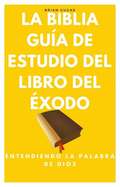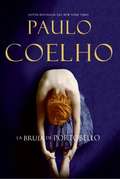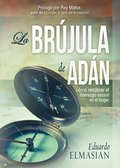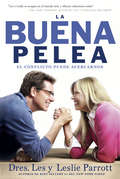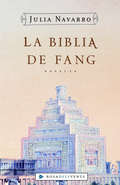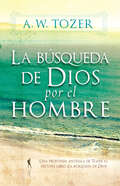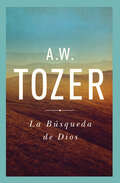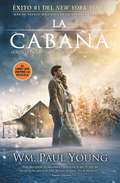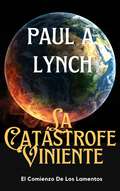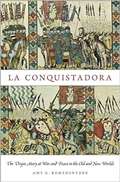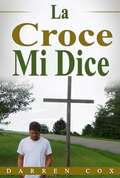- Table View
- List View
La Banda De Thunder Creek
by Courtenay KasperCuenta la historia de Ridge, un niño y su familia, y cómo encontró a Dios a través de su vida como abuelo
La Bande de Thunder Creek
by Courtenay KasperRidge Jones, onze ans, et sa sœur jumelle Libby découvrent que leur grand-père n’est pas le shérif qu’ils croyaient, ce qui les entraîne dans une aventure de la ruée vers l’or, de Cache Creek à Barkerville. Les jumeaux, terrifiés par les hors-la-loi tels que Rusty Roy, Bad Barry et leur bande ridicule de braqueur de trains, doivent se ruer à Barkerville avant qu’il ne soit trop tard pour sauver leur famille. Un aventure en pleine conquête de l’Ouest, avec de l’espoir, de la foi, et une chèvre insolente. Une histoire qui vous redonnera le sourire et l’espoir dans les moments difficiles !
La Belleza de las Cenizas
by Gabriel AgboUna de las virtudes que siempre ha alentado y alentará a los creyentes a aferrarse a Dios con tenacidad, incluso ante la aparente desesperanza y desesperación extrema, es su capacidad de cambiar las condiciones más desagradables en testimonios favorables. Es posible que usted haya hecho lo humanamente posible por salir de esa situación y fue en vano. Por desgracia, parece que después de todos sus esfuerzos, lo único que tiene es tristeza, dolor, arrepentimiento, pena, vergüenza y lágrimas. Es como si estuviera tentado a cuestionar el amor e incluso la existencia de Dios. No lo haga. Primero lea este libro. Dios está transformando para usted las cenizas en belleza.
La Belleza de una esposa: Centrada en Cristo, realizada en el matrimonio
by Sandy RalyaSandy Ralya fundó el ministerio Beautiful Womanhood en 2003 para ofrecer las mismas enseñanzas y orientación que cambiaron su vida y su matrimonio, y comenzó a hablar a cientos de mujeres cada año. Al escuchar las historias de mujeres como ella, Sandy se dio cuenta de la necesidad de recursos basados en enseñanzas prácticas, investigaciones sólidas y experiencias de la vida real. La belleza de una esposa usa estas historias inspiradoras junto con principios bíblicos para guiar y animar a cualquier mujer que esté buscando lo mejor de Dios para su matrimonio. Este libro responde preguntas serias que las mujeres tienen sobre su rol como esposas. Sandy habla de todo, desde el romance y el dinero hasta la belleza, la comunicación y el sexo, y reta a las mujeres a abrirse y compartir sus experiencias a fin de ver el plan de Dios para su matrimonio. "Mi pasión en la vida es ayudar a las mujeres a descubrir la voluntad de Dios para su matrimonio, igual que otras mujeres me ayudaron a mí", dice Sandy. "Cuando las mujeres comparten unas con otras los detalles de su vida, como esposas cristianas, es ciertamente algo hermoso."Sandy Ralya founded Beautiful Womanhood in 2003 to provide the same nurturing and mentoring that changed her life and her marriage and began to speak to hundreds of women each year. Hearing the stories of women like herself, Sandy realized the need for resources based on practical teaching, sound research, and real-life experiences. The Beautiful Wife uses these inspiring stories along with biblical principles to guide and encourage any wife looking for God's best in her marriage. The Beautiful Wife answers serious questions women have about their roles as wives. Discussing everything from romance and money to beauty, communication, and sex, Sandy challenges women to open up and share their journeys so that together they can see God's plan for their marriages.
La Biblia Para Principiantes: Historias Biblicas Para Ninos (I Can Read! #My First Shared Reading)
by ZonderkidzHeroes of the Bible is a 5-book treasury featuring the following Old Testament stories: Noah and the Ark Moses and the King Queen Esther Helps God’s People David and the Giant Daniel and the Lions Featuring The Beginner’s Bible artwork with easy-to-read text in the I Can Read, My First Level, this collection is sure to be a winner with parents looking for a way to share God’s Word with their youngsters. With the addition of a CD with the audio reading of each of these popular Bible stories, this hardcover edition will become a favorite to read and listen to over and over. Featuring dramatic voices, music, sound effects, and even a signal to let children know it’s time to turn the page, Heroes of the Bible is a perfect addition to any family bookshelf.
La Biblia contada a los niños: Historias del Antiguo Testamento y Nuevo Testamento
by Llorenç Ramis¡Una recopilación de historias de la Biblia para toda la familia! Disfruta en familia de los relatos más contados de la historia, con preciosas ilustraciones y un lenguaje adaptado a los más pequeños. Desde la creación del mundo hasta las enseñanzas de Jesús, estas historias son ideales para compartir los valores de respeto, generosidad y tolerancia que tan necesarios son en nuestros días. Faraones, leones y diluvios universales... En estas páginas exquisitamente ilustradas, los héroes del Antiguo y el Nuevo Testamento protagonizan relatos que con su simbología han definido la civilización en la que vivimos. El regalo perfecto para los más pequeños en el día de su Primera Comunión, ¡un recuerdo muy especial!
La Biblia en 52 semanas: Un estudio bíblico anual para la mujer (Bible in 52 Weeks)
by Dr. Kimberly D. MooreUn viaje de un año a través de la Biblia para fortalecer la fe de las mujeres.La Biblia siempre te ofrecerá una guía cuando tengas que enfrentar los desafíos de la vida o necesites levantar el ánimo. Este inspirador estudio bíblico para mujeres combina un plan diario de lecturas con acciones semanales para reflexionar, debatir y explorar cómo aplicar la sabiduría de Dios a tu vida diaria.Trasciende otras lecturas cristianas para mujeres con:Lecturas temáticas: cada versículo de la semana presenta temas y tópicos relacionados con la mujer moderna, como la perseverancia ante los desafíos o la superación de los errores, entre otros.Tu traducción favorita de la Biblia: incluye planes de lectura que te permiten trabajar con tu versión favorita de la Biblia para que logres una conexión más profunda con Dios.Diferentes maneras de estudiar: puedes explorar las preguntas interactivas, las sugerencias para llevar un diario bíblico y las oraciones por tu cuenta o de manera grupal.La versión en español de un libro muy querido: la edición traducida del best seller, La Biblia en 52 semanas: Un estudio bíblico anual para la mujer, ¡ahora disponible en español!Conoce la Palabra desde una nueva perspectiva y fortalece tu relación con Cristo a través de este estudio bíblico para mujeres.A yearlong journey through the Bible to strengthen women's faith—the Spanish language version.When you need to lift your spirits or tackle life's challenges, the Bible is always there to offer guidance. This inspiring Bible study for women combines a daily reading plan with weekly opportunities to reflect, discuss, and explore how God's wisdom can be applied to your daily life. Translated from the original version, this edition is available in Spanish!Themed readings—Every verse for the week features themes and topics that are relatable to modern women, like persevering through challenges, moving on from mistakes, and more.Your favorite Bible translation—The included reading plans work with any translation, allowing you to use your favorite Bible to connect with God more deeply.Different ways to study—You can explore the interactive questions, Bible journaling prompts, and prayers on your own or in a group setting.Spanish language version of a beloved book—This is a translated edition of the bestselling The Bible in 52 Weeks: A Yearlong Bible Study for Women, now available in Spanish!Get to know the Word in a new light and strengthen your relationship with Christ in this Spanish Bible study for women.
La Biblia en acción: The Action Bible Spanish Edition (Action Bible Series)
by Sergio CarielloCon más de 230 relatos bíblicos en orden cronológico y en formato de novela gráfica, La Biblia en acción edición ampliada en español ha ganado la reputación de entusiasmar tanto a niños, adolescentes, buscadores espirituales como a los amantes de los libros de historietas mientras descubren una vida de aventuras con Dios. Esta famosa edición ampliada de La Biblia en acción mejora la edición original al incluir: Historias adicionales del Antiguo Testamento sobre el viaje de Agar, las decisiones que tomaron las parteras en los días de Moisés y que cambiaron el mundo, y otras maneras en que Dios obró a través de Su pueblo.Fascinantes conexiones entre la historia de David y sus salmos.Un Nuevo Testamento actualizado que incluye parábolas y milagros previamente inexplorados.Más ilustraciones e información inspiradora acerca de las mujeres en la Biblia.Mapas mejorados para referencias más sencillas. 19 historias adicionales y 22 narraciones ampliadas junto con nuevas y llamativas ilustraciones de Sergio Cariello hacen de La Biblia en acción edición ampliada una singular manera de profundizar en la Palabra de Dios.With more than 230 chronological biblical narratives in the form of a graphic novel, The Action Bible Spanish Expanded Edition has gained a reputation for sparking excitement in kids, teens, seekers, and comic book lovers alike as they discover an adventurous life with God. This popular expanded edition of The Action Bible builds on the original to include: Additional Old Testament stories about Hagar&’s journey, the world-changing choices of the midwives in Moses&’s day, and other ways God worked through His people.Fascinating connections between David&’s story and his psalmsA refreshed New Testament including previously unexplored parables and miraclesMore empowering information and illustrations about women in the BibleEnhanced maps for easier reference An additional 19 stories and 22 expanded narratives, along with bold new illustrations from Sergio Cariello, make The Action Bible Expanded Edition a unique way to dig into God&’s Word.
La Biblia para principiantes - Historias acerca de Jesús (The Beginner's Bible)
by Kelly PulleyLa Biblia para principiantes ha sido uno de los libros favoritos de los niños y adultos desde su primera publicación, con más de 25 millones de productos vendidos. Este libro narra la historia de la vida de Jesús desde su humilde nacimiento hasta su vida adulta como predicador y maestro. Con nuevo arte vibrante y tridimensional y texto sencillo tomado La Biblia para principiantes, este libro será de gran interés para los niños por su mensaje del amor de Dios y sus historias de los milagros y las palabras de Jesús.
La Biblia para principiantes, 100 devocionales para la hora de dormir: Pensamientos y oraciones para finalizar el día (The Beginner's Bible)
by The Beginner's Bible¡Acomódate para pasar un momento especial con Dios y con tu pequeñito! La Biblia para principiantes, 100 Devocionales para la hora de dormir, contiene devociones tiernas y significativas de manera divertida y fácil de entender para los niños pequeños, a fin de que puedas terminar el día asegurándoles el increíble amor de Dios por ellos.Este hermoso libro de historias bíblicas es un complemento acogedor y lleno de fe para cualquier rutina antes de acostarse. Con devocionales organizados por temas, incluyendo gratitud, valor, amistad, paz y más, resulta fácil encontrar el mensaje perfecto para cualquier cosa que esté en el corazón o la mente de un niño.La Biblia para principiantes, 100 Devocionales para la hora de dormir:Forma parte de la marca The Beginner's Bible®, la marca de libros de historias bíblicas más vendida de nuestro tiempo, que ha impactado a más de 25 millones de familias durante más de 30 añosContiene 100 devocionales originales perfectos para compartir con los niños pequeñosOrganiza los devocionales por temas, para que puedas abordar fácilmente cualquier cosa en la que tu hijo esté pensandoEs una forma divertida y práctica de fortalecer la fe de su hijoPresenta un arte vibrante y tridimensionalEs perfecto para las cestas de Pascua, los rellenos de calcetines de Navidad, los cumpleaños y las dedicatorias.The Beginner&’s Bible 100 Bedtime DevotionsSnuggle up for some special time with God and your little one! The Beginner&’s Bible 100 Bedtime Devotions contains sweet, meaningful devotions that are fun and accessible for young children, so you can end the day by reassuring your child of God&’s amazing love for them.The Beginner&’s Bible 100 Bedtime Devotions is a cozy, faith-filled addition to any bedtime routine. With devotions organized by theme—including gratitude, courage, friendship, peace, and more—it&’s easy to find the perfect message for anything that&’s on a child&’s heart or mind.The Beginner&’s Bible 100 Bedtime Devotions:Is part of The Beginner&’s Bible® brand, the bestselling Bible storybook brand of our time, impacting more than 25 million families for over 30 yearsFeatures 100 original devotions perfect for sharing with young childrenOrganizes devotions by topic, so you can easily address anything your child is thinking aboutIs a fun, accessible way to deepen your child&’s faithFeatures vibrant, three-dimensional artIs perfect for Easter baskets, Christmas stocking stuffers, birthdays, and child dedications
La Biblia para principiantes, Primeras 100 palabras de la Biblia (The Beginner's Bible)
by The Beginner's Bible¿Buscas una forma divertida de enseñar a tus hijos pequeñitos acerca de la Biblia? Los primeros lectores aprenderán sus primeras palabras, en el marco de las historias bíblicas clásicas con La Biblia para principiantes, primeras 100 palabras de la Biblia.Este libro de cartón bellamente ilustrado, que presenta imágenes de gran atractivo para los niños, ofrece:Dar a los lectores principiantes de 0 a 4 años la oportunidad de aprender palabras de las historias bíblicas más queridas.Un formato resistente y perfecto para las manos pequeñas de los niños.Atractivo arte en 3D con hermosos detalles para mantener la atención de los pequeñitos.La Biblia para principiantes, primeras 100 palabras de la Biblia es ideal para:Cumpleaños, canastas de Pascua, bautismo, dedicación y regalos de vacaciones.Viajes por carretera, para romper el aburrimiento y para el tiempo de actividades.Uso en la escuela, en casa y en el ministerio de niños (escuela dominical).La Biblia para principiantes ha sido la Biblia ilustrada favorita de niños y padres desde su lanzamiento, con más de 25 millones de productos vendidos en inglés y español.The Beginner's Bible First 100 Bible WordsAre you looking for a fun way to teach your toddler about the Bible? Early readers will learn their first words set within classic Bible stories with The Beginner&’s Bible First 100 Bible Words.Presenting child-friendly illustrations, this beautifully illustrated board book offers:Gives emerging readers ages 0-4 an opportunity to learn words from beloved Bible storiesA sturdy format that is perfect for toddlers&’ little handsEngaging 3D art with plenty of details to hold a young child&’s attention The Beginner&’s Bible First 100 Bible Words is great for:Birthdays, Easter baskets, Children's Baptism, and holiday giftingRoad trips, boredom busters, and activity timeHome school and Children&’s Ministry (Sunday school) useThe Beginner's Bible has been a favorite illustrated Bible with young children and their parents since its release in 1989 with over 25 million products sold in English and Spanish.
La Biblia para principiantes: una guía básica para principiantes
by Brian Gugas Paula De MonteDescripción del libro: A lo largo de los tiempos, las personas han acudido a la Biblia en busca de guía y esperanza. Este libro de estudio de la Biblia sirve como un mapa de carreteras para que los principiantes puedan desarrollar una apreciación de la Biblia y convertirla en parte de su vida diaria. Los 66 libros de la Biblia se tratan en detalle, incluidos los siguientes temas: * Autor de cada libro y el marco de tiempo en el que se escribió. * Temas principales de cada libro. * Resumen del mensaje de cada libro. * Un devocional para la meditación y un mayor análisis. Sumérjase en las historias, las profecías y los mensajes de la Biblia y vuelva a descubrir la fuerza que inspira sobrecogimiento, misericordia y el poder sanador de Dios y Jesucristo. Llena de gracia e inspiración, Guía de estudio de la Biblia para principiantes hace volver al lector a los aspectos básicos y abre el camino hacia una relación directa con la Palabra viva de Dios.
La Biblia y sus secretos: Un viaje sin censura al libro más vendido del mundo
by Juan AriasUn viaje sin censura al libro más vendido del mundo. La Biblia es la gran novela de la Humanidad, con sus derrotas y sus victorias, su deseo de liberación de todas las esclavitudes y la constatación, al mismo tiempo, de que la vida no es más que un puñado de arena que se escapa, con asombrosa rapidez, por las rendijas del tiempo. Este libro surge del convencimiento de que la Biblia es capaz de «hablar» a todos, y de que quizás aún contenga más secretos de los que imaginamos. Con lenguaje divulgativo y a la vez con rigor cultural, trato de explicar a los lectores -y a mí mismo también- la apasionante historia, desde sus orígenes hasta la actualidad, de la más grande epopeya literaria y religiosa de todos los tiempos: la Biblia, el único libro declarado Patrimonio de la Humanidad.
La Biblia, Guía de Estudio del Libro del Éxodo: Entendiendo la Palabra de Dios
by Brian GugasLa Biblia, Guía de Estudio del Libro del Éxodo, es parte de la serie de libros de Brian Gugas, que nos ayuda a tener una mayor comprensión de la maravillosa Palabra de Dios. Como el mismo Autor lo dirá, es un Libro de Comienzos y Finales. Por sus particulares características, también es un libro que nos transporta al lugar, tras bambalinas, de la historia que se desarrolla y nos aclara el panorama de todo lo que ocurre en este increíble peregrinaje. Nos corre distintos velos que la brecha del tiempo y lo cultural no nos permitían vislumbrar completamente, y profundiza la urgencia de ser consientes de la demanda de Dios hacia nosotros por rendirnos completamente a Su Voluntad.
La Bruja de Portobello
by Paulo CoelhoFonoLibro se enorgullece en presentar el más reciente bestseller del laureado escritor brasileño Paolo Coelho, "La Bruja de Portobello," en una maravillosa producción dramatizada, con un elenco competo, una bellísima música y efectos de sonido. Athena es una mujer con un don. Su familia adoptiva, una madre libanesa y un padre, prospero empresario en Beirut, se traslada a Londres cuando estalla la guerra en su país. Allí, en la universidad Athena conoce al padre de su hijo, pero las dificultades de la joven hacen que el matrimonio pronto se rompa. Convertida en madre, no puede dejar de pensar en la mujer que la trajo al mundo y, para entender cómo pudo abandonarla, decide emprender un viaje a Rumania y buscar a su madre biológica. Pero el viaje no la lleva sólo a dónde pensaba y en el recorrido Athena hace un descubrimiento que cambia para siempre su vida y las de los que la rodean. En La bruja de Portobello, Coelho ofrece una trama fascinante y llena de intriga, a través de la cual el lector descubre una antigua tradición basada en la fuerza femenina y en el amor. La bruja de Portobello relata la vida de Athena mediante la gente que la conocía bien o que no la conocía nada. Entre ellos, su madre adoptiva, un periodista, una sacerdotisa, un historiador y una actriz. Cada persona ilustra un aspecto diferente del carácter de Athena, describiendo lo que vieron y experimentaron y también compartiendo sus propias impresiones, creencias e inquietudes.
La Brújula de Adán: Cómo recobrar el liderazgo varonil en el hogar
by Eduardo ElmasianVarón, ¿Es usted la cabeza del hogar? Ocupe la posición de líder de la familia que Dios le ha dado. Jesús vino a guiarlo.Cuando Adán permitió que Eva tomara decisiones que no le correspondían perdió su "brújula", es decir, su posición de liderazgo. Esa pérdida provocó que ambos vagaran sin saber llegar a Dios. La buena noticia es que a través de Jesús la humanidad ha recuperado el sentido de dirección.Es importante entender en estos tiempos que el esposo y padre de familia nunca debe ceder su timón de liderazgo en el hogar. Este es el diseño de Dios para mantener a las familias en la ruta correcta. En La brújula de Adán el autor enseña cómo recobrar el vital liderazgo varonil en los hogares.Incluye temas como:Escuchar a la esposaLos efectos del narcisismoLa diferencia entre líder y jefeY mucho más
La Buena Pelea: El conflicto puede acercarnos
by Les Parrott Leslie ParrottNYT best-selling authors Drs. Les & Leslie Parrott reveal new techniques based on extensive research that help couples manage conflict constructively - that's the "good fight."
La BÍblia de Fang
by Julia NavarroA Roma, un home es confessa: «Pare, macuso perquè mataré un home...».Al mateix temps Clara Tannenberg, una jove arqueòloga néta dun home poderós amb un passat fosc, anuncia en un congrés el descobriment dunes tauletes que, si són autèntiques, seran la prova científica de lexistència del patriarca Abraham: és lobra dun escriba que va recollir el relat del profeta sobre la creació del món, la confusió de les llengües a Babel y el diluvi universal. Una auténtica Bíblia de Fang. Amb un equip darqueòlegs, i poc abans de linici de lúltima guerra del Golf, Clara posa en marxa unes excavacions arriscades quefan que nhi hagi molts que vulguin acabar amb la seva vida i la del seu avi: des de traficants dart milionaris fins a quatre amics que no claudicaran fins a culminar una venjança implacable.Després de lespectacular èxit de La germandat del Sant Sudari, Julia Navarro es consagra amb aquesta novel·la electritzant, en laqual el lector viatjarà fins als temps bíblics passant per lEuropa de la Segona Guerra Mundial, Egipte, Síria, els Estats Units, Itàlia, França, Espanya i lIraq de Saddam.
La Búsqueda De Dios Por El Hombre: Una profunda antesala de Tozer al exitoso libro La búsqueda de Dios
by A. W. TozerLa búsqueda de Dios por el hombre habla fervientemente del deseo que Dios tiene porque el hombre se salve y la acción que toma al invadir el alma humana.
La Búsqueda De Dios: Un Clásico Libro Devocional
by A. W. TozerDurante un viaje en tren desde Chicago a Texas a fines de la década de 1940, A.W. Tozer empezó a escribir La Búsqueda De Dios. Escribió durante toda la noche, las palabras surgiendo a su mente al ritmo que las podía apuntar. Cuando el tren llegó a McAllen, el borrador estaba terminado.A pesar de haber sido escrito en tan poco tiempo, la profundidad, claridad e integridad del mensaje de A.W. Tozer han hecho que La Búsqueda De Dios sea un libro favorito hasta presente. Más de 1.5 millones de ejemplares han sido impresos en 20 idiomas.Prepárese para una experiencia de profundo significado y deleite.-------------------------------------------------------------------------Tozer's bestseller, this book has been called "one of the all-time most inspirational books" by a panel of Christian magazine writers.Sometimes the voices that speak most clearly in the present are those that echo from the past. So it is in this Christian classic by the late pastor and evangelist A. W. Tozer. Tozer brings the mystics to bear on modern spirituality, grieving the hustle and bustle and calling for a slow, steady gaze upon God. With prophetic vigor and flowing prose, he urges us to replace low thoughts of God with lofty ones, to quiet our lives so we can know God&’s presence. He reminds us that life apart from God is really no life at all. Tozer writes from his knees, a posture fit for presenting the character of God in all its demanding grandeur. "Arise, O sleeper!" is his word to us, and yet if we heed the call, we will see that to arise is not to stand, but to kneel before the God of heaven in humble contemplation. To pursue God is to know Him, and in our knowing be drawn in.
La Búsqueda De Dios: Un Clásico Libro Devocional
by A. W. TozerDurante un viaje en tren desde Chicago a Texas a fines de la década de 1940, A.W. Tozer empezó a escribir La Búsqueda De Dios. Escribió durante toda la noche, las palabras surgiendo a su mente al ritmo que las podía apuntar. Cuando el tren llegó a McAllen, el borrador estaba terminado.A pesar de haber sido escrito en tan poco tiempo, la profundidad, claridad e integridad del mensaje de A.W. Tozer han hecho que La Búsqueda De Dios sea un libro favorito hasta presente. Más de 1.5 millones de ejemplares han sido impresos en 20 idiomas.Prepárese para una experiencia de profundo significado y deleite.-------------------------------------------------------------------------Tozer's bestseller, this book has been called "one of the all-time most inspirational books" by a panel of Christian magazine writers.Sometimes the voices that speak most clearly in the present are those that echo from the past. So it is in this Christian classic by the late pastor and evangelist A. W. Tozer. Tozer brings the mystics to bear on modern spirituality, grieving the hustle and bustle and calling for a slow, steady gaze upon God. With prophetic vigor and flowing prose, he urges us to replace low thoughts of God with lofty ones, to quiet our lives so we can know God&’s presence. He reminds us that life apart from God is really no life at all. Tozer writes from his knees, a posture fit for presenting the character of God in all its demanding grandeur. "Arise, O sleeper!" is his word to us, and yet if we heed the call, we will see that to arise is not to stand, but to kneel before the God of heaven in humble contemplation. To pursue God is to know Him, and in our knowing be drawn in.
La Cabana: Donde La Tragedia Se Encuentra Con La Eternidad
by Wm. Paul YoungMackenzie Allen Phillips's youngest daughter, Missy, has been abducted during a family vacation, and evidence that she may have been brutally murdered is found in an abandoned shack deep in the Oregon wilderness. Four years later, in this midst of his great sadness, Mack receives a suspicious note, apparently from God, inviting him back to that shack for a weekend. Against his better judgment he arrives at the shack on wintry afternoon and walks back into his darkest nightmare. What he finds there will change his life forever.
La Catástrofe Viniente: El Comienzo de los Lamentos
by Paul A. LynchJesús profetizó sobre los últimos tiempos y el comienzo de los pesares. El tiempo del fin de la era está más cerca de lo que pensamos. ¿Qué hora estamos viviendo? La respuesta es que estamos viviendo en el tiempo del fin: este es el comienzo de los pesares. Los padres lucharán contra los hijos y viceversa. La brujería y lo oculto están cada vez más en aumento. La gente está felizmente casada y el divorcio es la norma. El hermano está traicionando a su hermano incluso hasta la muerte, y lo mismo los padres con los hijos. La enfermedad y las plagas están en aumento. Y la tecnología es el nuevo dios de la época. El anticristo y el Orden Mundial Único están sobre nosotros, este también conocido como el Nuevo Orden Mundial. La Marca de la Bestia aún no se ha emitido; sin embargo, los diversos consejos la respaldan plenamente. ¿Quieres saber qué te depara el futuro y el de la tierra? ¿Quieres saber quién será el anticristo y qué hará? ¿Deseas comprender las profecías bíblicas y otros asuntos relacionados con la Biblia relacionados con los últimos tiempos y la verdadera vida cristiana? Si eres esa persona, lee este libro. Apocalipsis 13:16 “Y él hace que todos, pequeños y grandes, ricos y pobres, libres y con fianza, reciban una marca en su mano derecha, o en sus frentes:” 17 “Y que ningún hombre pueda comprar o vender, excepto el que tenga en él la marca, el nombre de la bestia o el número de su nombre". 18 Aquí hay sabiduría. El que tiene entendimiento, cuente el número de la bestia: porque es el número de un hombre; y su número es seiscientos sesenta y seis". Marcos 13:8 "Porque se levantará nación contra nación, y reino contra reino; y habrá terremotos en diversos lugares, y habrá hambres y problemas: estos son los comienzos de los pesares".
La Conquistadora: The Virgin Mary At War And Peace In The Old And New Worlds
by Amy G. RemensnyderWhile most books about Mary emphasize her role as the compassionate mother of God, this book uncovers her significant role as an active and often belligerent patron of warfare, as seen from the mosques and castles of medieval Iberia to the cities and shrines of colonial Mexico and finally to present-day New Mexico. Amy Remensnyder explores Mary's prominence on and off the battlefield in the culturally and ethnically diverse world of medieval Iberia, where Muslims, Christians, and Jews lived side by side, and in colonial Mexico, where Spaniards and indigenous peoples mingled. As this array of peoples turned to her to articulate their identities, Mary was drawn into both hostile and peaceful cross-cultural encounters. Although Mary became an icon of the Christian conquest of Muslims, medieval Muslims and Christians shared her, sometimes even joining together in rituals of worship in her churches. In the New World, some indigenous peoples of the Americas appropriated from the Spanish the idea of Mary as Conquistadora, using it to reinforce the identity they fashioned for themselves as native conquistadors. Offering a ground-breaking look at the Virgin Mary, La Conquistadora connects medieval and early modern understandings of this iconic figure to reveal her enduring legacy.
La Croce Mi Dice
by Darren CoxAdelphi può anche essere una piccola città, ma ospita un tesoro che non può essere misurato. Quando Bill McFar arriva in città in cerca di un carico utile, trova quello che vuole sotto la collina di Adelphi: una fonte di petrolio. Ma il petrolio di McFar si trova sotto qualcosa di importante per la gente di Adelphi. Su quel pendio erboso poggia una grande croce di legno che rappresenta la speranza della gente e li ispira nella loro vita quotidiana. Nessuno ad Adelphi vuole che la croce si sposti per facilitare l'avidità di McFar. Ma è potente. E risoluto. McFar otterrà la sua strada e sradicherà questo faro, offendendo le tradizioni e la fede dei cittadini? Oppure la storia della croce farà in modo che le cose vadano in un altro modo.....?
